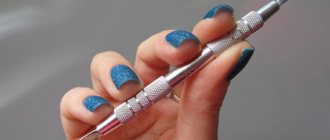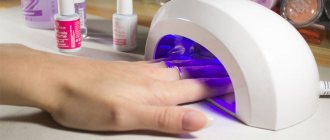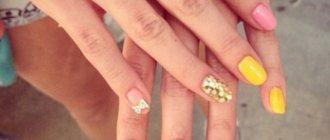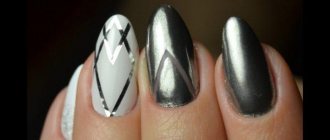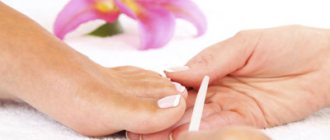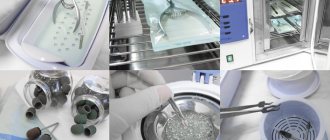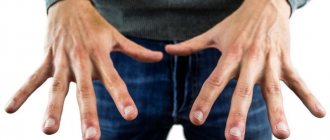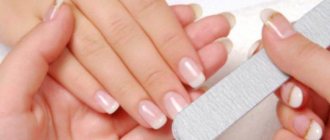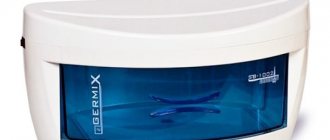- September 17, 2018
- Nail care
- Tatiana Pekha
Hands with a high-quality manicure look neat and well-groomed. This result can be achieved using a special device (milling cutter). It will help you quickly and easily perform the perfect manicure, as well as prevent damage to the delicate cuticle skin. The safety of hardware manicure reduces the risk of contracting infectious diseases, which is why more and more masters are using a milling machine. To get a flawless manicure, you need to be able to choose the right cutters, each of which will perform different functions. In this article we will look at the description of manicure cutters, their markings and purpose.
Variety of cutters
So-called milling cutters are used as attachments for the router, which differ in abrasiveness and tip diameter. Also, some cutters may have speed restrictions. By counting the number of notches on manicure cutters, you can determine the degree of hardness of the nozzle. There are several well-known manufacturers on the modern market that offer a huge number of cutters.
Depending on the purpose, all nozzles can be divided into three main groups:
- filing and shaping nails;
- polishing the surface of the nail plate;
- polishing nails and skin.
There is also a narrower distribution of attachments based on other characteristics.
How to sterilize cutters?
Manicure cutters should not contain residues of dirt, bacteria or infections.
Sterilization of hardware instruments occurs using specialized disinfecting solutions:
- Alaminol.
- Optimax.
- Gigasept.
- Blanidas.
- Korzolex.
These products are sold in concentrated form. To disinfect instruments, you need to prepare them. This is done by adding 3 tbsp. l. drug in 1 liter of cold, clean water.
When sterilizing cutters, it is important to consider the hardness of the material and the depth of the notches of the nozzle.
The soft coating will deteriorate after prolonged disinfection, so it is necessary to reduce the time. The average treatment time in the solution is 30 – 40 minutes.
After immersion in the solution, the cutters undergo the following processing stages:
- Cleaning under running water.
- Manual cleaning with a brass brush.
- Ultrasonic treatment.
- Immersion in dry heat or autoclave.
Material for making manicure cutters
Milling cutters are made from different materials, depending on which they are divided into the following types:
- Ceramic cutters (baked). Such attachments are usually used to prepare the nail plate.
- Metal nozzles (carbide). Used to treat nails and cuticles.
- Diamond cutters (from artificial or natural stone). They are often used to clean the nail from pterygium and cuticle.
- Combined or silicon carbide cutters. Nozzles for various purposes.
The shape and diameter of the cutters depend on their purpose. Next, we’ll look at each type of attachment in more detail, and also find out what the colored notches on the cutters mean.
Application of ceramic tools
Ceramic attachments are used both at home and in the salon, for a professional router. The abrasiveness (hardness) of ceramic cutters is less than that of diamond-coated bits. They are needed for treating difficult areas of the skin: cleaning rough and keratinized tissue, removing calluses, removing artificial covering and grinding down thick nails. When purchasing a device, a standard set of cutters is often chosen, but ceramic attachments are quite expensive and must be purchased separately. The rigidity of such cutters is determined by the number of notches and is indicated by the following colored bands:
- Pink or blue - less than 100 microns.
- White - less than 200 microns.
- Black - less than 400 microns.
A colored belt (flag) is located at the base of the nozzle. Each cutter must be marked depending on its hardness.
Metal
Metal attachments can be made of medical (alloy) or carbide steel. Using metal cutters you can: process the cuticle, remove dead skin in areas around the nail.
A carbide cutter made of carbide and tungsten is practically not used for processing natural nails, as there is a risk of injuring the nail plate. You can use such a rigid cutter to remove gel or acrylic coating. Metal nozzles differ from other categories in the principle of their operation. They do not file down skin, nails or artificial turf, but rather cut them in a thin layer, resulting in fine shavings rather than dust.
The metal nozzles have notches: straight, cross-shaped and oblique. The toughest is the straight cut. On cutters for manicure you can often find cross-shaped notches, since they are more difficult to clog, and masters prefer durable use. Metal cutters are reversible (rotate in both directions), which makes the work easier for a left-handed craftsman. This type of cutter is considered universal; many operations can be performed with their help. Metal attachments perfectly polish the skin, and can also file away the hard coating on the nails and adjust their length.
How are cutters different?
Studying what they are intended for and what manicure cutters are on sale today, it is worth noting their main differences. This will make it easier to choose the right tool.
It is worth immediately noting that machines for hardware manicure are initially distinguished by their functionality. Some of them are used in beauty salons, while others are used at home. Accordingly, the basic set of attachments differs significantly. For home use, purchase a machine with the most modest set of attachments. However, they can be used to perform several very basic functions.
For professional use, functional equipment is purchased. It allows you to perform almost all operations when creating a manicure and pedicure. If you need to expand the set of cutters, they can always be purchased separately. Everything you need can be found in specialized stores.
When studying why and which attachment for a manicure apparatus is used in the process of nail care, it should be noted that they differ in the size of the tip. It is necessary to install the tool in the chuck. Therefore, you need to purchase a rotating attachment exclusively in accordance with the model of your manicure machine. In addition, each of them has a certain speed limit.
Diamond
These attachments are used to treat thin nails and sensitive skin. Diamond cutters allow you to level the nail plate and smooth out its unevenness. Cutters with a small diameter help polish the roller in the area near the nail plate, and a large nozzle size can eliminate calluses. Depending on the manufacturing method of cutters, the following types are distinguished:
- Precipitated (stone chips attached to a blank base).
- Sintered (diamond chips together with glue can be processed under high temperature).
Such cutters need to be changed every 3-4 months.
Combined
Such attachments are called “sand caps”, and they are used mainly by beginners. The combination of silicon and carbide allows you to use such cutters with convenience and without fear of injuring the client. The price of combined cutters is relatively low. Typically, such caps are included in the standard set of cutters when purchasing a router. Professionals rarely use silicon carbide attachments and throw them away after the manicure procedure, as the crumbs on the cap quickly rub off. Combined cutters cannot be sterilized, so they are disposed of in the salon.
There are several degrees of hardness of silicon carbide caps:
- To remove shine from the nail plate, use up to 80 units of abrasive.
- Polishing a nail requires up to 150 units.
- Final polishing requires 300 hardness units.
The functions performed by combination attachments can easily be performed by more practical cutters that can be sterilized.
Color designations of notches on manicure cutters
The colored band on the cutters indicates the degree of abrasiveness of the nozzle. Hardware manicure is performed using cutters with different levels of rigidity. How and when should you choose the right cutter? First you need to figure out what the colored notches on manicure cutters mean. Let's look at 5 categories:
- A black belt is indicated on the most brutal cutters. Such attachments are not used for processing natural nails, much less skin. The “black” cutter is used only for sawing artificial material.
- The green flag is rarely used and only for working with dead skin and calluses. A ceramic cutter with such a notch is used to remove artificial material.
- The blue color of the belt on cutters is used quite often, especially on diamond bits. It is used to treat cuticles and side ridges.
- Red cutters are needed for almost any manicure; they are very soft, but suitable for working with both natural nails and skin.
- The most gentle cutter is yellow. Any beginner can use it without fear of damaging the skin or nails.
A beginner can use 3-5 different cutters to get a quality manicure. An experienced craftsman who has decided on the sawing technique can work with 1-2 cutters. It is important to determine the optimal sawing technique for each client individually, because for some, the skin of their hands is damp and the cutter will become clogged, while for others, a hard attachment can injure the skin.
Top 5 indispensable attachments for beginners
For manicure, use 1 attachment or all at once: it depends on the presence or absence of calluses and other growths, dry cuticles, and keratinized skin.
Flame cutter
This is an attachment necessary for lifting and cleaning the cuticle; it is used to treat the sinuses. It is not easy for beginners to work with it due to the fact that it has a roundness in the middle, as a result of which cuts are allowed. You need to hold this cutter at an angle of 45°.
Needle cutter
A needle cutter, also known as a fissure cutter, is an ideal attachment for lifting and opening the cuticle. When correction of an extended nail is performed, it can be used to file the natural nail from the inside. To avoid hitting the sharp end, the cutter should always be kept parallel to the nail.
Ball cutter
It's a sphere. It is used to cut the cuticle. Side rollers and burrs are also destroyed with its irreplaceable help. Where exactly it is used is determined by size.
Cylinder cutter
Necessary for filing nails to their overall length and shaping them. It is often used when you need to remove gel polish. Since the nozzle is traumatic, beginners should be especially careful when using it.
Cylinder cutter
It is also called a roller and is used to cut the cuticle and side ridges safely for the nail.
Milling cutter shapes
The purpose of manicure cutters can be easily determined by looking at their shape. It can be spherical (burs), trapezoidal, “drum”, cylindrical and conical. The trapezoid is similar to a porous sponge and is used for polishing the nail plate, and also helps to cut down nicks and smoothes the nail. Attachments with a small ball at the end allow you to remove small cracks in the nail, as well as overgrown cuticles and pterygium. Cuticle removal occurs very gently, without trauma to the nail plate. The cylinder varies in width and thickness. It performs an impressive list of functions:
- used to create an original design;
- needed to correct the length of nails;
- indispensable for removing old coating.
Due to its versatility, a cylindrical cutter can be found in any set of cutters that comes with a manicure machine. “Drum” with a high level of rigidity is intended for:
- removing rough skin;
- adjusting the length of thick nails;
- alignment of the nail plate.
Cone-shaped cutters are needed for final filing and polishing of the nail. The final stage of manicure is performed using soft cutter materials (rubber, plastic, cotton, silicone, felt). You can achieve a pleasant shine on your nails using an attachment coated with polymer.
Full classification of cutters
To correctly compile the right list of cutters for a beginner, you need to carefully study their descriptions and find out the purpose of each attachment.
By material
- Ceramic . The safest possible attachments, as they are very soft. They do not heat up, do not become clogged with dust, and do not rust. The main disadvantage is instability to wear. They are usually used when working with a recently purchased device in order to get used to it. Abrasiveness: from 100 to 400 microns. The nail plate is polished with fine-grained cutters and finishing work is carried out on the skin; Medium-grained ones are ideal for processing cuticles, and coarse-grained ones allow you to effectively remove dead skin.
- Diamond . More rigid, and therefore more functional. Used for polishing nails, both natural and extended, modeling the free edge of the nail, processing and polishing the side ridges, interdigital space and calluses. On sale you can find both natural diamond (more expensive) and artificial diamond chips (cheaper).
- Carbide or corundum . They are used at the beginning of a hardware manicure to remove a layer of rough skin, drill out hard calluses, remove a layer of acrylic, treat hard-to-reach places and work with ingrown nails. Ideal for working with artificial nails. They heat up very little during operation, which means they do not cause discomfort. The recommended speed for working with nozzles is up to 15,000 rpm.
- Steel . Teeth are formed by cutting or stamping. Often the tool is oxidized to improve its performance.
The master will tell you how to choose the right attachments for manicure:
Check out a more detailed review of manicure cutters from a professional:
By shape
| Form | Types of operations |
| Olive (bud, oval) | Removes cuticles, makes minor adjustments, and processes side rollers. |
| Straight cylinder | Saws off the modeling layer (tips, gel, acrylic). |
| Needle | Removes gel polish, helps in correcting gel nails, and is suitable for removing detachments near the cuticle and artificial material. |
| Ball | It gets rid of small growths and cracks, and also removes a strip of rough skin without harming the plate. |
| Rounded cylinder | Polishes nails. Removes calluses, polishes acrylic. |
| Flame | Processes side ridges, removes artificial material, drills a place for rhinestones or nail piercing. |
| Cone | Grinds and polishes. |
| truncated cone | Grinds and polishes. |
| Pointed cylinder | Opens sinuses, treats ridges. |
| Reverse cone | For treating the nail plate before French manicure. Using the nozzle, you can make the tip as smooth as possible and without changes in height. |
All cutters differ in the diameter of the working part, as well as the degree of abrasiveness.
